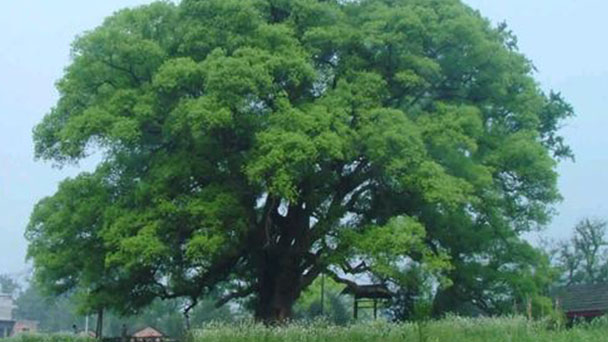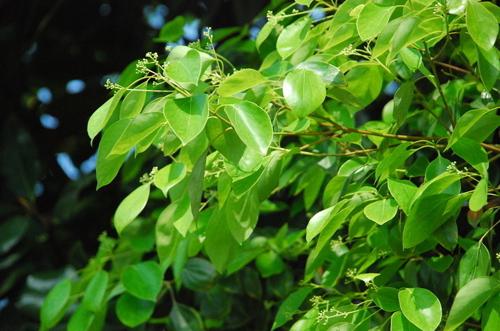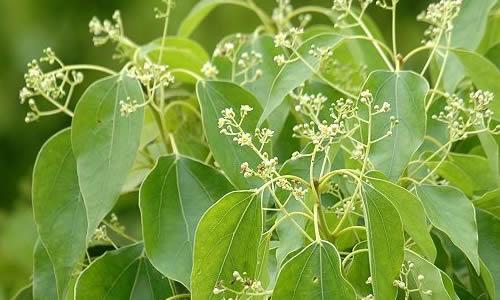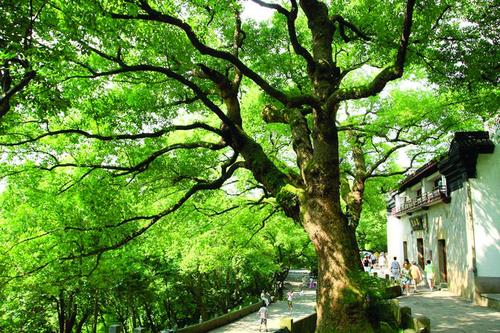Camphor tree (Cinnamomum camphora) profile
Written by Maggie
Mar 31 2021

Camphor tree (Cinnamomum camphora), also known as camphorwood or camphor laurel, is a large evergreen tree of the order Cinnamomum, family Lauraceae and genus Cinnamomum, up to 30 m high and 3 m in diameter, with broad oval crowns; Extensive canopy, thick branches and leaves, imposing manner, Camphor tree is an excellent green tree, street trees and court shade trees.
Camphor tree is produced in the southern and southwestern provinces of China. Vietnam, Korea, Japan also have distribution, other countries often introduced cultivation. All plants have a camphor aroma, camphor and camphor oil can be extracted. Wood is hard and beautiful, suitable for furniture and boxes. Camphor tree is resistant to chlorine, sulfur dioxide, ozone and fluorine and other harmful gases. It can drive away mosquitoes and flies and can withstand short-term flooding. It is the main raw material for Camphor production. The material is excellent and it is a good material for making furniture.
Camphor trees picture

Morphological characteristics of Camphor trees
Appearance
Camphor tree is a large evergreen tree, up to 30 meters high and 3 meters in diameter, with a broad oval crown; Branches, leaves and wood all have the smell of camphor; Bark is yellowish-brown, with irregular longitudinal cracks. The terminal bud is broadly ovate or globose, scales broadly ovate or suborbicular, slightly silky hairs outside. Branches are cylindrical, light brown, glabrous.
Leaf
Camphor tree leaves are alternate, elliptic, oval 6 ~ 12 cm long, 2.5 5.5 cm wide, apex acute, base broadly cuneate to subrounded, margin entire, it is sometimes microwave, the green or yellow-green, luster, yellow-green or under the sage green, dark, glabrous or slightly pilose on was slightly below, with from basal veins 3, sometimes the transition to the base doesn't have five veins, midrib on both sides, each side has upper lateral veins 1 ~ 3 ~ 5 (7). There are a few branches on one side of the basal lateral vein to the leaf margin. There is an obvious glandular fossa on the upper side of the lateral vein and the lower side of the branch vein axial, and the fossa is often pubescent. Petiole of Camphor tree is slender, 2 ~ 3 cm long, concave back convex, glabrous. The bark is green when young, smooth, old gradual yellowish-brown or grayish-brown longitudinal crack; Winter buds are ovoid.
Flowers
Camphor tree is a panicle axillary, 3.5 -- 7 cm long, pedicel, 2.5-4.5 cm long, glabrous or covered with grayish to yellowish-brown puberulent with all levels of rachis, often conspicuous at nodes when covered. Flowers are green-white or yellowish, ca. 3 mm long; Pedicels are 1 -- 2 mm long, glabrous. The perianth is glabrous outside or puberulent, inner densely pubescent, perianth tube obtapered, ca. 1 mm long, perianth lobes elliptic, ca. 2 mm long.Fertile stamens 9, ca. 2 mm, filaments pubescent. Camphor tree has 3 stamens, innermost, arrowhead-shaped, ca. 1 mm long, pubescent. Ovary is globose, ca. 1 mm long, glabrous, style ca. 1 mm.
Fruit
Fruit of Camphor tree is ovoid or subglobose, 6 -- 8 mm in diam., purplish-black; Fruit receptacle is cup-shaped, ca. 5 mm long, truncated at apex, to 4 mm wide, ca. 1 mm wide at the base, longitudinally furred.
Ecological habits of Camphor tree
Camphor tree is adapted to an altitude of less than 1800 m, and can grow up to 1000 m in the south and southwest regions of the Yangtze River. Camphor tree grew in the subtropical soil fertile sunny slopes, valleys and riparian flat. It is also often cultivated on hillsides or valleys.
Camphor tree prefers light and tolerates shade; They like warm and humid climate and are not strong in cold resistance. Camphor trees are suitable for growing in sandy loam soil and are more resistant to water and humidity. However, attention should be paid to maintaining soil moisture when transplanting, because waterlogging is easy to lead to the death of rot roots due to oxygen deficiency, but they are not resistant to drought, barren and saline-alkali soil. Taproot developed deep roots, wind resistance. Camphor tree has strong germination force, resistant to pruning. The growth rate is medium, the tree shape is huge as an umbrella, can shade cool. With a long life span, it can grow into towering ancient trees of hundreds of thousands of years. Camphor tree has a strong ability to smoke and hold back dust, conserve water, fix soil and prevent sand and beautify the environment.
The distribution area of the Camphor tree
Camphor tree is produced in the southern and southwestern provinces of China. Vietnam, Korea, Japan also have distribution, other countries often introduced cultivation.
Camphor tree grows most widely in the Yibin area of Sichuan province. The main breeding and breeding bases are Shuyang, Zhejiang, and Anhui in Jiangsu Province.
How to grow and care for Camphor tree
1. Light
Camphor tree is an excellent potted leaf-viewing plant, which likes dampness, avoids sunlight and is drought-resistant
Therefore it is unfavorable full illumination, summer should be appropriate shading, especially in July to August full illumination and strong illumination, the chlorophyll of the leaf is destroyed and cause sapling death.
The best light for a Camphor tree is from 7 am to 11 am for about four hours each day, shorter in the summer and longer in the fall and spring. However, the absence of light also affects the photosynthesis and growth of the Camphor tree.
Be sure not to put it in the holiday with the west light, do not put it next to the air outlet of the air conditioner or the heater, otherwise the water of the Camphor tree leaves will be evaporated, easy to dehydration and dry breakfast.
2. Soil
It is best to be able to use loose, fertile, water, breathable soil. In addition, attention should be paid to fertilizing along the basin wall as far as possible, not close to the root of the Camphor tree.
Generally, newly bought camphor tree bonsai will have nutritive soil, and it does not need to be fertilized for three months. After three months, it will be fertilized once every two to three months.
3. Moisture
For the cultivation of the Camphor tree, it is necessary to observe the surface of the soil in the basin. If the soil is slightly yellow-white and the leaves are slightly curled, it is not necessary to water the soil, but only to spray the leaves. When the soil in the basin is white, it should be watered to the soil in the basin. Remember to water it once, so that the soil can absorb enough water in the basin.
4. Temperature
Compared with common plants, the Camphor tree is more suitable for indoor display due to its characteristics of shade resistance, low-temperature resistance, evergreen, strong resistance to adversity and extensive management
Camphor tree has very good low-temperature resistance, temperature as high as more than 40 degrees in summer, winter low temperature below zero, in the case of the four seasons temperature difference is so big, Camphor tree can grow well, still has quite a strong vitality, is a typical couch potato plants, often without water, soil, suitable for extensive management, easy to survive, so is suitable for the urban population growing fast pace of life now.

Camphor tree pests & disease
Camphor tree is susceptible to Anthracnose, Armillaria, Phytophthora, Root Rot and Verticillium.
Camphor tree uses
Medical use
Camphor trees can promote blood circulation, eliminating rheumatism. Treat upper vomiting and diarrhea, abdominal swelling and pain, rheumatism arthralgia, injury, scabies and itching.
Camphor tree garden use
Camphor tree branches and leaves thick, the shadow of big thick, tree majestic appearance, can smoke dust, water conservation, soil sand fixation, and beautify the environment, is the urban greening tree species, fine widely as a court shade trees, trees, shelter forest, and scenic beauty is often used for ornamental, village, gardens, schools, institutions, factories, former hill, the courtyard, the side of the road, buildings. Planting pool, water side, hillside, etc. Cluster planting, group planting, solitary planting or as a background tree in the grassland is magnificent, and because of its strong resistance to a variety of toxic gases, strong ability to absorb dust, is often used in cities and industrial and mining areas. And Camphor tree can absorb harmful gases, like the neighborhood, factories, both sides of the road, square, campus green are quite appropriate.

Latest Updated
- Benefits of Bugleweed - 7 Science-backed Health Benefits
- Bugleweed Dangers & Side Effects - Is It Poisonous?
- How to Plant Evergreen Trees - What You Should Know
- When to Plant Evergreens - Grow Guide for Evergreen Trees
- 12 Wonderful Evergreen Shrubs for Your Garden
- 12 Popular Evergreen Plants with Pictures for Beginners
- When And How To Prune A Lilac Bush Like a Pro
- How to Grow & Care for Lilac Vine (Hardenbergia Violacea)
- Japanese Lilac Tree (Syringa Reticulata) Care & Propagation Guide
- Shumard Oak Pros and Cons - What to Know
Popular Articles
- Winter maintenance of Antirrhinum Majus
- How to Grow Terminalia Mantaly Tree
- How to Grow and Care for Crossostephium Chinense
- How to grow Antirrhinum Majus in spring
- Peristeria Elata (Dove Orchid) Profile: Info & Care Guide
- Underwatered Snake Plant (Sansevieria Trifasciata) - Signs And How To Fix
- How to Care for Brazilian Jasmine Plant (Mandevilla Sanderi)
- How to Grow & Care for Graptopetalum Purple Delight in Summer
- Rosa Chinensis (China Rose): Plant Growing & Care Tips
- How to Care for Baby Sun Rose (Aptenia Cordifolia)